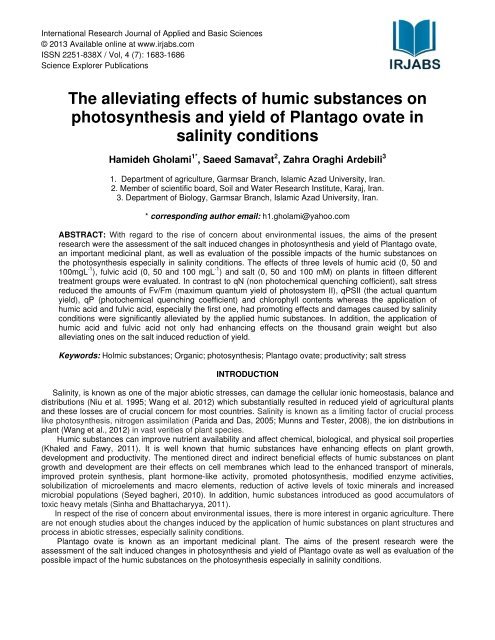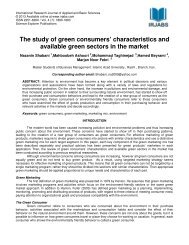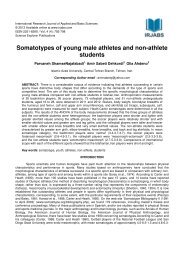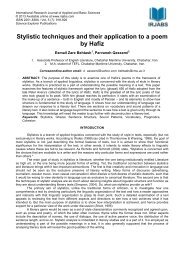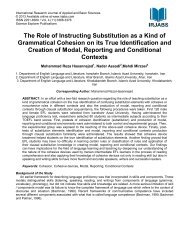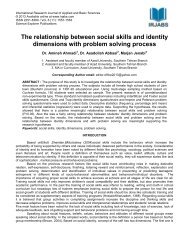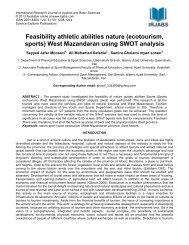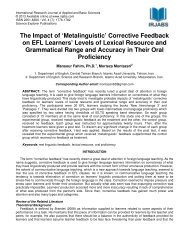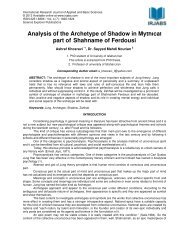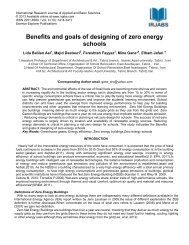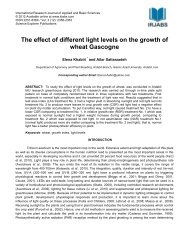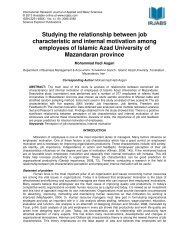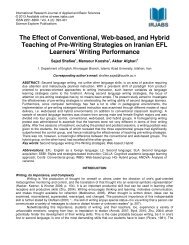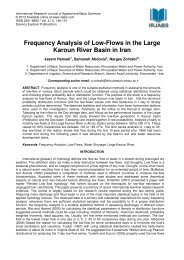The alleviating effects of humic substances on ... - irjabs.com
The alleviating effects of humic substances on ... - irjabs.com
The alleviating effects of humic substances on ... - irjabs.com
Create successful ePaper yourself
Turn your PDF publications into a flip-book with our unique Google optimized e-Paper software.
Internati<strong>on</strong>al Research Journal <str<strong>on</strong>g>of</str<strong>on</strong>g> Applied and Basic Sciences<br />
© 2013 Available <strong>on</strong>line at www.<strong>irjabs</strong>.<strong>com</strong><br />
ISSN 2251-838X / Vol, 4 (7): 1683-1686<br />
Science Explorer Publicati<strong>on</strong>s<br />
<br />
<str<strong>on</strong>g>The</str<strong>on</strong>g> <str<strong>on</strong>g>alleviating</str<strong>on</strong>g> <str<strong>on</strong>g>effects</str<strong>on</strong>g> <str<strong>on</strong>g>of</str<strong>on</strong>g> <str<strong>on</strong>g>humic</str<strong>on</strong>g> <str<strong>on</strong>g>substances</str<strong>on</strong>g> <strong>on</strong><br />
photosynthesis and yield <str<strong>on</strong>g>of</str<strong>on</strong>g> Plantago ovate in<br />
salinity c<strong>on</strong>diti<strong>on</strong>s<br />
Hamideh Gholami 1* , Saeed Samavat 2 , Zahra Oraghi Ardebili 3<br />
1. Department <str<strong>on</strong>g>of</str<strong>on</strong>g> agriculture, Garmsar Branch, Islamic Azad University, Iran.<br />
2. Member <str<strong>on</strong>g>of</str<strong>on</strong>g> scientific board, Soil and Water Research Institute, Karaj, Iran.<br />
3. Department <str<strong>on</strong>g>of</str<strong>on</strong>g> Biology, Garmsar Branch, Islamic Azad University, Iran.<br />
* corresp<strong>on</strong>ding author email: h1.gholami@yahoo.<strong>com</strong><br />
ABSTRACT: With regard to the rise <str<strong>on</strong>g>of</str<strong>on</strong>g> c<strong>on</strong>cern about envir<strong>on</strong>mental issues, the aims <str<strong>on</strong>g>of</str<strong>on</strong>g> the present<br />
research were the assessment <str<strong>on</strong>g>of</str<strong>on</strong>g> the salt induced changes in photosynthesis and yield <str<strong>on</strong>g>of</str<strong>on</strong>g> Plantago ovate,<br />
an important medicinal plant, as well as evaluati<strong>on</strong> <str<strong>on</strong>g>of</str<strong>on</strong>g> the possible impacts <str<strong>on</strong>g>of</str<strong>on</strong>g> the <str<strong>on</strong>g>humic</str<strong>on</strong>g> <str<strong>on</strong>g>substances</str<strong>on</strong>g> <strong>on</strong><br />
the photosynthesis especially in salinity c<strong>on</strong>diti<strong>on</strong>s. <str<strong>on</strong>g>The</str<strong>on</strong>g> <str<strong>on</strong>g>effects</str<strong>on</strong>g> <str<strong>on</strong>g>of</str<strong>on</strong>g> three levels <str<strong>on</strong>g>of</str<strong>on</strong>g> <str<strong>on</strong>g>humic</str<strong>on</strong>g> acid (0, 50 and<br />
100mgL -1 ), fulvic acid (0, 50 and 100 mgL -1 ) and salt (0, 50 and 100 mM) <strong>on</strong> plants in fifteen different<br />
treatment groups were evaluated. In c<strong>on</strong>trast to qN (n<strong>on</strong> photochemical quenching c<str<strong>on</strong>g>of</str<strong>on</strong>g>ficient), salt stress<br />
reduced the amounts <str<strong>on</strong>g>of</str<strong>on</strong>g> Fv/Fm (maximum quantum yield <str<strong>on</strong>g>of</str<strong>on</strong>g> photosystem II), qPSII (the actual quantum<br />
yield), qP (photochemical quenching coefficient) and chlorophyll c<strong>on</strong>tents whereas the applicati<strong>on</strong> <str<strong>on</strong>g>of</str<strong>on</strong>g><br />
<str<strong>on</strong>g>humic</str<strong>on</strong>g> acid and fulvic acid, especially the first <strong>on</strong>e, had promoting <str<strong>on</strong>g>effects</str<strong>on</strong>g> and damages caused by salinity<br />
c<strong>on</strong>diti<strong>on</strong>s were significantly alleviated by the applied <str<strong>on</strong>g>humic</str<strong>on</strong>g> <str<strong>on</strong>g>substances</str<strong>on</strong>g>. In additi<strong>on</strong>, the applicati<strong>on</strong> <str<strong>on</strong>g>of</str<strong>on</strong>g><br />
<str<strong>on</strong>g>humic</str<strong>on</strong>g> acid and fulvic acid not <strong>on</strong>ly had enhancing <str<strong>on</strong>g>effects</str<strong>on</strong>g> <strong>on</strong> the thousand grain weight but also<br />
<str<strong>on</strong>g>alleviating</str<strong>on</strong>g> <strong>on</strong>es <strong>on</strong> the salt induced reducti<strong>on</strong> <str<strong>on</strong>g>of</str<strong>on</strong>g> yield.<br />
Keywords: Holmic <str<strong>on</strong>g>substances</str<strong>on</strong>g>; Organic; photosynthesis; Plantago ovate; productivity; salt stress<br />
INTRODUCTION<br />
Salinity, is known as <strong>on</strong>e <str<strong>on</strong>g>of</str<strong>on</strong>g> the major abiotic stresses, can damage the cellular i<strong>on</strong>ic homeostasis, balance and<br />
distributi<strong>on</strong>s (Niu et al. 1995; Wang et al. 2012) which substantially resulted in reduced yield <str<strong>on</strong>g>of</str<strong>on</strong>g> agricultural plants<br />
and these losses are <str<strong>on</strong>g>of</str<strong>on</strong>g> crucial c<strong>on</strong>cern for most countries. Salinity is known as a limiting factor <str<strong>on</strong>g>of</str<strong>on</strong>g> crucial process<br />
like photosynthesis, nitrogen assimilati<strong>on</strong> (Parida and Das, 2005; Munns and Tester, 2008), the i<strong>on</strong> distributi<strong>on</strong>s in<br />
plant (Wang et al., 2012) in vast verities <str<strong>on</strong>g>of</str<strong>on</strong>g> plant species.<br />
Humic <str<strong>on</strong>g>substances</str<strong>on</strong>g> can improve nutrient availability and affect chemical, biological, and physical soil properties<br />
(Khaled and Fawy, 2011). It is well known that <str<strong>on</strong>g>humic</str<strong>on</strong>g> <str<strong>on</strong>g>substances</str<strong>on</strong>g> have enhancing <str<strong>on</strong>g>effects</str<strong>on</strong>g> <strong>on</strong> plant growth,<br />
development and productivity. <str<strong>on</strong>g>The</str<strong>on</strong>g> menti<strong>on</strong>ed direct and indirect beneficial <str<strong>on</strong>g>effects</str<strong>on</strong>g> <str<strong>on</strong>g>of</str<strong>on</strong>g> <str<strong>on</strong>g>humic</str<strong>on</strong>g> <str<strong>on</strong>g>substances</str<strong>on</strong>g> <strong>on</strong> plant<br />
growth and development are their <str<strong>on</strong>g>effects</str<strong>on</strong>g> <strong>on</strong> cell membranes which lead to the enhanced transport <str<strong>on</strong>g>of</str<strong>on</strong>g> minerals,<br />
improved protein synthesis, plant horm<strong>on</strong>e-like activity, promoted photosynthesis, modified enzyme activities,<br />
solubilizati<strong>on</strong> <str<strong>on</strong>g>of</str<strong>on</strong>g> microelements and macro elements, reducti<strong>on</strong> <str<strong>on</strong>g>of</str<strong>on</strong>g> active levels <str<strong>on</strong>g>of</str<strong>on</strong>g> toxic minerals and increased<br />
microbial populati<strong>on</strong>s (Seyed bagheri, 2010). In additi<strong>on</strong>, <str<strong>on</strong>g>humic</str<strong>on</strong>g> <str<strong>on</strong>g>substances</str<strong>on</strong>g> introduced as good accumulators <str<strong>on</strong>g>of</str<strong>on</strong>g><br />
toxic heavy metals (Sinha and Bhattacharyya, 2011).<br />
In respect <str<strong>on</strong>g>of</str<strong>on</strong>g> the rise <str<strong>on</strong>g>of</str<strong>on</strong>g> c<strong>on</strong>cern about envir<strong>on</strong>mental issues, there is more interest in organic agriculture. <str<strong>on</strong>g>The</str<strong>on</strong>g>re<br />
are not enough studies about the changes induced by the applicati<strong>on</strong> <str<strong>on</strong>g>of</str<strong>on</strong>g> <str<strong>on</strong>g>humic</str<strong>on</strong>g> <str<strong>on</strong>g>substances</str<strong>on</strong>g> <strong>on</strong> plant structures and<br />
process in abiotic stresses, especially salinity c<strong>on</strong>diti<strong>on</strong>s.<br />
Plantago ovate is known as an important medicinal plant. <str<strong>on</strong>g>The</str<strong>on</strong>g> aims <str<strong>on</strong>g>of</str<strong>on</strong>g> the present research were the<br />
assessment <str<strong>on</strong>g>of</str<strong>on</strong>g> the salt induced changes in photosynthesis and yield <str<strong>on</strong>g>of</str<strong>on</strong>g> Plantago ovate as well as evaluati<strong>on</strong> <str<strong>on</strong>g>of</str<strong>on</strong>g> the<br />
possible impact <str<strong>on</strong>g>of</str<strong>on</strong>g> the <str<strong>on</strong>g>humic</str<strong>on</strong>g> <str<strong>on</strong>g>substances</str<strong>on</strong>g> <strong>on</strong> the photosynthesis especially in salinity c<strong>on</strong>diti<strong>on</strong>s.
Intl. Res. J. Appl. Basic. Sci. Vol., 4 (7), 1683-1686, 2013<br />
<br />
MATERIAL AND METHODS<br />
<str<strong>on</strong>g>The</str<strong>on</strong>g> experimental design was <strong>com</strong>pletely randomized. Plantago ovate plants were grown at a mean<br />
temperature cycle <str<strong>on</strong>g>of</str<strong>on</strong>g> 25°C (day)/15°C (night) and relative humidity <str<strong>on</strong>g>of</str<strong>on</strong>g> 35%. <str<strong>on</strong>g>The</str<strong>on</strong>g> <str<strong>on</strong>g>effects</str<strong>on</strong>g> <str<strong>on</strong>g>of</str<strong>on</strong>g> three levels <str<strong>on</strong>g>of</str<strong>on</strong>g> <str<strong>on</strong>g>humic</str<strong>on</strong>g> acid<br />
(0, 50 and 100mgL -1 ), fulvic acid (0, 50 and 100 mgL -1 ) and salt (0, 50 and 100 mM) <strong>on</strong> plants were evaluated. Two<br />
m<strong>on</strong>th old plants were fertilized two times with two week intervals by different menti<strong>on</strong>ed c<strong>on</strong>centrati<strong>on</strong>s <str<strong>on</strong>g>of</str<strong>on</strong>g> <str<strong>on</strong>g>humic</str<strong>on</strong>g><br />
and fulvic acid. Salt treatments were d<strong>on</strong>e two times with three day intervals three days after the last fertilizati<strong>on</strong>.<br />
<str<strong>on</strong>g>The</str<strong>on</strong>g> details <str<strong>on</strong>g>of</str<strong>on</strong>g> the used soil analysis were presented in table 1. <str<strong>on</strong>g>The</str<strong>on</strong>g> seedlings were grouped in 15 different<br />
treatment groups including c<strong>on</strong>trol (C), S50, S100, F50, F50-S50 , F50-S100 , F100, F100-S50, F100-S100, H50,<br />
H50-S50, H50-S100,H100, H100-S50,H100-S100 (H, F and S refer to the <str<strong>on</strong>g>humic</str<strong>on</strong>g>, fulvic and salt respectively and<br />
the numbers show the used c<strong>on</strong>centrati<strong>on</strong>s).<br />
Chlorophyll fluorescence was measured from the last developed leaves using a fluorometer (PAM-2000, Walz,<br />
Germany). Parameters including qPS II (the actual quantum yield in the light-adapted steady state), qP<br />
(photochemical quenching coefficient), qN (n<strong>on</strong> photochemical quenching coefficient) and Fv/Fm (maximum<br />
quantum yield <str<strong>on</strong>g>of</str<strong>on</strong>g> photosystem II) were determined.<br />
Chlorophyll c<strong>on</strong>tents were analyzed with chlorophyll meter (Minolta SPAD-502, Japan).<br />
Plant yield was estimated based <strong>on</strong> thousand grain weight in each treatment group.<br />
Analysis <str<strong>on</strong>g>of</str<strong>on</strong>g> variance was performed <strong>on</strong> all data using SPSS s<str<strong>on</strong>g>of</str<strong>on</strong>g>tware. Duncan test with probability <str<strong>on</strong>g>of</str<strong>on</strong>g> 0.05 was<br />
applied to assess any significant differences between treatments.<br />
Parameters<br />
EC<br />
PH<br />
Organic matter<br />
Organic carb<strong>on</strong><br />
P<br />
K<br />
N<br />
Table 1. the details <str<strong>on</strong>g>of</str<strong>on</strong>g> the used soil.<br />
Amounts<br />
1.31 ds/m<br />
7.72<br />
1.2 %o/m<br />
0.7%o/m<br />
2.46 mgL -1<br />
599 mgL -1<br />
0.003 mgL -1<br />
RESULTS AND DISCUSSION<br />
As it was shown in table 2, salt stress had reducing <str<strong>on</strong>g>effects</str<strong>on</strong>g> <strong>on</strong> the amounts <str<strong>on</strong>g>of</str<strong>on</strong>g> Fv/Fm whereas the applicati<strong>on</strong><br />
oh <str<strong>on</strong>g>humic</str<strong>on</strong>g> acid and fulvic acid, especially the first <strong>on</strong>e, had promoting <str<strong>on</strong>g>effects</str<strong>on</strong>g> and the negative <str<strong>on</strong>g>effects</str<strong>on</strong>g> <str<strong>on</strong>g>of</str<strong>on</strong>g> salt stress<br />
were significantly alleviated by the applied <str<strong>on</strong>g>humic</str<strong>on</strong>g> <str<strong>on</strong>g>substances</str<strong>on</strong>g>. Although the salinity c<strong>on</strong>diti<strong>on</strong>s, especially the<br />
sec<strong>on</strong>d used level, resulted in the reduced qPSII, the applicati<strong>on</strong> <str<strong>on</strong>g>of</str<strong>on</strong>g> <str<strong>on</strong>g>humic</str<strong>on</strong>g> acid and fulvic acid, especially the first<br />
<strong>on</strong>e, decreased detrimental <str<strong>on</strong>g>effects</str<strong>on</strong>g> <str<strong>on</strong>g>of</str<strong>on</strong>g> stress (table 2). <str<strong>on</strong>g>The</str<strong>on</strong>g> applicati<strong>on</strong> <str<strong>on</strong>g>of</str<strong>on</strong>g> <str<strong>on</strong>g>humic</str<strong>on</strong>g> and fulvic acid individually were<br />
ineffective to promote qP whereas effective to alleviate damaging <str<strong>on</strong>g>effects</str<strong>on</strong>g> <str<strong>on</strong>g>of</str<strong>on</strong>g> salt stress (table 2). In c<strong>on</strong>trast to the<br />
<str<strong>on</strong>g>effects</str<strong>on</strong>g> <str<strong>on</strong>g>of</str<strong>on</strong>g> salinity c<strong>on</strong>diti<strong>on</strong>s <strong>on</strong> qP, qPSII and Fv/Fm, the amounts <str<strong>on</strong>g>of</str<strong>on</strong>g> qN were increased in salt treated plants<br />
however, the applied treatments <str<strong>on</strong>g>of</str<strong>on</strong>g> <str<strong>on</strong>g>humic</str<strong>on</strong>g> acid and fulvic acid were significantly effective to ease the salt stress<br />
(table 2). In <strong>com</strong>paris<strong>on</strong> to the c<strong>on</strong>trol samples, the decreased chlorophyll c<strong>on</strong>tents were observed in individually<br />
salt treated plants, S50 and S100, whereas the enhanced <strong>on</strong>es were found in <str<strong>on</strong>g>humic</str<strong>on</strong>g> and fulvic treated groups and<br />
the best results recorded in H50 and H100 (table 3). <str<strong>on</strong>g>The</str<strong>on</strong>g> results presented in table 2 and 3 indicated that damages<br />
induced by salinity c<strong>on</strong>diti<strong>on</strong>s were declined by the applied treatments <str<strong>on</strong>g>of</str<strong>on</strong>g> <str<strong>on</strong>g>humic</str<strong>on</strong>g> acid and fulvic acid, especially the<br />
first <strong>on</strong>e. As it was presented in table 3, the applicati<strong>on</strong> <str<strong>on</strong>g>of</str<strong>on</strong>g> <str<strong>on</strong>g>humic</str<strong>on</strong>g> acid and fulvic acid not <strong>on</strong>ly had enhancing <str<strong>on</strong>g>effects</str<strong>on</strong>g><br />
<strong>on</strong> the yield but also <str<strong>on</strong>g>alleviating</str<strong>on</strong>g> <strong>on</strong>es <strong>on</strong> the salt induced reducti<strong>on</strong> <str<strong>on</strong>g>of</str<strong>on</strong>g> thousand grain weight. However, <str<strong>on</strong>g>humic</str<strong>on</strong>g> acid<br />
c<strong>on</strong>centrati<strong>on</strong>s <str<strong>on</strong>g>of</str<strong>on</strong>g> 100 were not effective as much as 50. It seems that the enhanced nutrient uptakes and induced<br />
physiological changes by the applied treatment <str<strong>on</strong>g>of</str<strong>on</strong>g> <str<strong>on</strong>g>humic</str<strong>on</strong>g> acid or fulvic acid, especially the first <strong>on</strong>e, were<br />
resp<strong>on</strong>sible for the obtained results in this study.<br />
A declined photosynthetic quantum c<strong>on</strong>versi<strong>on</strong> is assessed by a decline in the values <str<strong>on</strong>g>of</str<strong>on</strong>g> the Chl fluorescence<br />
ratio Fv/Fm (Lichtenthaler and Burkart, 1999). It has been reported that photosynthesis is extremely sensitive to<br />
varieties <str<strong>on</strong>g>of</str<strong>on</strong>g> abiotic stresses (Sadder et al., 2013). Salt stress in sorghum plants resulted in the significantly reduced<br />
maximum quantum yield <str<strong>on</strong>g>of</str<strong>on</strong>g> photosystem II (Fv/Fm), photochemical quenching coefficient (qP) and electr<strong>on</strong><br />
transport rate (ETR) as well as increased photochemical quenching (Net<strong>on</strong>do et al. 2004). It has been stated that<br />
sensitivity to salt stress in cereals may be correlated with decreases in PSII photochemical efficiency and elevated<br />
qN, in order to dissipate the excess energy (Moradi and Ismail 2007). <str<strong>on</strong>g>The</str<strong>on</strong>g> declined photochemical reacti<strong>on</strong>s,<br />
especially with the mediati<strong>on</strong> <str<strong>on</strong>g>of</str<strong>on</strong>g> PSII, which is occurred in plants exposed to various stresses and ac<strong>com</strong>panied by<br />
the chlorophyll losses, may be caused by the destroyed chloroplast structure, destabilizati<strong>on</strong> <str<strong>on</strong>g>of</str<strong>on</strong>g> pigment protein
Intl. Res. J. Appl. Basic. Sci. Vol., 4 (7), 1683-1686, 2013<br />
<br />
<strong>com</strong>plexes, limited CO2 fixati<strong>on</strong> and enhanced photorespirati<strong>on</strong> (Sadder et al. 2013). <str<strong>on</strong>g>The</str<strong>on</strong>g> fast chlorophyll a<br />
fluorescence transient analysis indicated that salt restricted the maximum quantum yield <str<strong>on</strong>g>of</str<strong>on</strong>g> PSII photochemistry<br />
(F v /F m ), occurred in plants exposed stress was resulted from the damage at the receptor side <str<strong>on</strong>g>of</str<strong>on</strong>g> PSII (Shu et al.<br />
2012). In additi<strong>on</strong>, the microscopic analysis reflected that salt stress led to the damaged chloroplast envelope,<br />
increased number <str<strong>on</strong>g>of</str<strong>on</strong>g> plastoglobuli al<strong>on</strong>g with abnormal thylakoid membranes (Shu et al. 2012). <str<strong>on</strong>g>The</str<strong>on</strong>g> results<br />
presented here showed that the applicati<strong>on</strong> <str<strong>on</strong>g>of</str<strong>on</strong>g> <str<strong>on</strong>g>humic</str<strong>on</strong>g> <str<strong>on</strong>g>substances</str<strong>on</strong>g> not <strong>on</strong>ly had promoting <str<strong>on</strong>g>effects</str<strong>on</strong>g> <strong>on</strong> chlorophyll<br />
c<strong>on</strong>tents and photosynthesis but also <str<strong>on</strong>g>alleviating</str<strong>on</strong>g> <strong>on</strong>es <strong>on</strong> damages caused by the salt stress. It seems that the<br />
<str<strong>on</strong>g>effects</str<strong>on</strong>g> <str<strong>on</strong>g>of</str<strong>on</strong>g> <str<strong>on</strong>g>humic</str<strong>on</strong>g> <str<strong>on</strong>g>substances</str<strong>on</strong>g> <strong>on</strong> plants may be selective and variable, depend <strong>on</strong> their c<strong>on</strong>centrati<strong>on</strong> and the<br />
medium pH (Nardi et al. 2002). Humic <str<strong>on</strong>g>substances</str<strong>on</strong>g> can facilitate respirati<strong>on</strong> and photosynthesis processes via<br />
modified functi<strong>on</strong>ing <str<strong>on</strong>g>of</str<strong>on</strong>g> mitoch<strong>on</strong>dria and chloroplasts (Orlov et al. 2005). <str<strong>on</strong>g>The</str<strong>on</strong>g> negative <str<strong>on</strong>g>effects</str<strong>on</strong>g> <str<strong>on</strong>g>of</str<strong>on</strong>g> the envir<strong>on</strong>mental<br />
stresses <strong>on</strong> plants can be alleviated by the use <str<strong>on</strong>g>of</str<strong>on</strong>g> <str<strong>on</strong>g>humic</str<strong>on</strong>g> <str<strong>on</strong>g>substances</str<strong>on</strong>g> (Orlov et al. 2005). As it was shown by the<br />
decreased thousand grain weight, it seems that the observed reducti<strong>on</strong> in plant biomass can be due to a<br />
<strong>com</strong>binati<strong>on</strong> <str<strong>on</strong>g>of</str<strong>on</strong>g> slower growth and development, caused by osmotic stress, inhibited photosynthesis process as<br />
well as altered source-sink metabolism and relati<strong>on</strong>s. <str<strong>on</strong>g>The</str<strong>on</strong>g> limited plant yield in salinity c<strong>on</strong>diti<strong>on</strong> has been attributed<br />
to the osmotic stress, restricted photosynthesis mainly because <str<strong>on</strong>g>of</str<strong>on</strong>g> salt induced changes in photosynthetic<br />
apparatus and sink capacity (Kato and Takeda 1996; Di<strong>on</strong>sio-Sese and Tobita 2000; Shani and Ben-Gal 2005).<br />
Stomatal c<strong>on</strong>ductance, reduced sink activity, decreased Rubisco efficiency, displacement <str<strong>on</strong>g>of</str<strong>on</strong>g> essential cati<strong>on</strong>s,<br />
changes in membrane permeability, excessive generati<strong>on</strong> <str<strong>on</strong>g>of</str<strong>on</strong>g> reactive oxygen species (ROS) in chloroplasts and<br />
swollen and disorganized grana are proposed as a possible reas<strong>on</strong> for inhibiting <str<strong>on</strong>g>effects</str<strong>on</strong>g> <str<strong>on</strong>g>of</str<strong>on</strong>g> salinity <strong>on</strong><br />
photosynthesis process (Di<strong>on</strong>isio-Sese and Tobita 2000; Desingh et al. 2007; Moradi and Ismail 2007; Chaves et<br />
al. 2009).<br />
In c<strong>on</strong>clusi<strong>on</strong>, the obtained results from the present research indicate that the applicati<strong>on</strong> <str<strong>on</strong>g>of</str<strong>on</strong>g> <str<strong>on</strong>g>humic</str<strong>on</strong>g> <str<strong>on</strong>g>substances</str<strong>on</strong>g>,<br />
especially at suitable c<strong>on</strong>centrati<strong>on</strong>s, may alleviate the damages induced by the stress, probably via the enhanced<br />
nutrient uptakes and induced physiological changes.<br />
Table 2. the <str<strong>on</strong>g>effects</str<strong>on</strong>g> <str<strong>on</strong>g>of</str<strong>on</strong>g> <str<strong>on</strong>g>humic</str<strong>on</strong>g> acid, fulvic acid and/or salt stress <strong>on</strong> different parameters related to the photosynthesis in Plantago<br />
ovate.<br />
Treatments<br />
qPSII<br />
qP<br />
qN<br />
Fv/Fm<br />
C<br />
0.64 abc<br />
0.9967 a<br />
0.26 ef<br />
0.637 c<br />
S50<br />
0.5767 de<br />
0.9133 ab<br />
0.3933 b<br />
0.448 d<br />
S100<br />
0.3933 h<br />
0.8267 c<br />
0.45 a<br />
0.4d<br />
F50<br />
0.6233 abcd<br />
0.9733 ab<br />
0.22 g<br />
0.705 ab<br />
F50-S50<br />
0.4967 g<br />
0.9533 ab<br />
0.3567 c<br />
0.637 c<br />
F50-S100<br />
0.5233 efg<br />
0.91 ab<br />
0.4567 a<br />
0.689 abc<br />
F100<br />
0.5833 cd<br />
0.9833 ab<br />
0.2633 fg<br />
0.68 abc<br />
F100-S50<br />
0.5867 bcd<br />
0.9733 ab<br />
0.2967 de<br />
0.678 abc<br />
F100-S100<br />
0.5167 fg<br />
0.9033 b<br />
0.31 d<br />
0.674 abc<br />
H50<br />
0.65 a<br />
0.9933 a<br />
0.2033g a<br />
0.72 a<br />
H50-S50<br />
0.5233 efg<br />
0.9767 ab<br />
0.28 de<br />
0.655 abc<br />
H50-S100<br />
0.5 g<br />
0.91 ab<br />
0.2867 de<br />
0.69 abc<br />
H100<br />
0.6433 ab<br />
0.9867 ab<br />
0.23 fg<br />
0.71 a<br />
H100-S50<br />
0.6033 abcd<br />
0.96 ab<br />
0.2667 ef<br />
0.69 abc<br />
H100-S100<br />
0.5667 def<br />
0.9133 ab<br />
0.2867 de<br />
0.676 abc<br />
*: Mean values followed by different letters are significantly different at P
Intl. Res. J. Appl. Basic. Sci. Vol., 4 (7), 1683-1686, 2013<br />
<br />
ACKNOWLEDGEMENTS<br />
This study was supported by the Islamic Azad University, Garmsar branch. Authors would like to thank Dr.<br />
A Ladan Mogadam for his pr<str<strong>on</strong>g>of</str<strong>on</strong>g>essi<strong>on</strong>al and warming helps.<br />
REFERENCES<br />
Chaves MM, Flexas J, Pinheiro C. 2009. Photosynthesis under drought and salt stress: regulati<strong>on</strong> mechanisms from whole plant to cell. Ann<br />
Bot. 103: 551–560.<br />
Desingh R, Kanagaraj G. 2007. Influence <str<strong>on</strong>g>of</str<strong>on</strong>g> salinity stress <strong>on</strong> photosynthesis and antioxidative systems in two cott<strong>on</strong> varieties. Gen Appl Plant<br />
Physiol. 33 (3-4): 221-234.<br />
Di<strong>on</strong>isio-Sese ML, Tobita S. 2000. Effects <str<strong>on</strong>g>of</str<strong>on</strong>g> salinity <strong>on</strong> sodium c<strong>on</strong>tent and photosynthetic resp<strong>on</strong>ses <str<strong>on</strong>g>of</str<strong>on</strong>g> rice seedlings differing in salt<br />
tolerance. J Plant Physiol. 157: 54–58.<br />
Kato T, Takeda K. 1996. Associati<strong>on</strong>s am<strong>on</strong>g characters related to yield sink capacity in spaced-planted rice. Crop Sci. 36: 1135–1139.<br />
Khaled H, Fawy HA. 2011. Effect <str<strong>on</strong>g>of</str<strong>on</strong>g> different Levels <str<strong>on</strong>g>of</str<strong>on</strong>g> <str<strong>on</strong>g>humic</str<strong>on</strong>g> Acids <strong>on</strong> the nutrient c<strong>on</strong>tent, plant growth and soil properties under c<strong>on</strong>diti<strong>on</strong>s <str<strong>on</strong>g>of</str<strong>on</strong>g><br />
salinity. Soil Water Res. 6(1): 21–29.<br />
Lichtenthaler HK, Burkart S. 1999. Photosynthesis and high light stress. Bulg J Plant Physiol. 25(3–4): 3–16.<br />
Moradi F, Ismail AM. 2007. Resp<strong>on</strong>ses <str<strong>on</strong>g>of</str<strong>on</strong>g> Photosynthesis, Chlorophyll Fluorescence and ROS-Scavenging Systems to Salt Stress during<br />
Seedling and Reproductive Stages in Rice. Ann Bot. 99: 1161–1173.<br />
Munns R, Tester M. 2008. Mechanisms <str<strong>on</strong>g>of</str<strong>on</strong>g> salinity tolerance. Annu Rev Plant Biol. 59:651–681.<br />
Nardi S, Pizzeghello D, Muscolo A, Vianello A. 2002. Physiological <str<strong>on</strong>g>effects</str<strong>on</strong>g> <str<strong>on</strong>g>of</str<strong>on</strong>g> <str<strong>on</strong>g>humic</str<strong>on</strong>g> <str<strong>on</strong>g>substances</str<strong>on</strong>g> <strong>on</strong> higher plants. Soil Biol Biochem. 34: 1527–<br />
1536.<br />
Net<strong>on</strong>do GW, Onyango JC, Beck E. 2004. Sorghum and salinity: II. Gas exchange and chlorophyll fluorescence <str<strong>on</strong>g>of</str<strong>on</strong>g> sorghum under salt stress.<br />
Crop Sci. 44: 806–811.<br />
Niu X, Bressan RA, Hasegawa PM, Pardo JM. 1995. I<strong>on</strong> homeostasis in NaCl stress envir<strong>on</strong>ments. Plant Physiological, 109: 735–742.<br />
Orlov DS, Sadovnikova LK. 2005. Soil organic matter and protective functi<strong>on</strong>s <str<strong>on</strong>g>of</str<strong>on</strong>g> <str<strong>on</strong>g>humic</str<strong>on</strong>g> <str<strong>on</strong>g>substances</str<strong>on</strong>g> in the biosphere. Printed in the Netherlands.<br />
Springer.<br />
Parida AK, Das AB. 2005. Salt tolerance and salinity <str<strong>on</strong>g>effects</str<strong>on</strong>g> <strong>on</strong> plants: A review. Ecotoxicol Envir<strong>on</strong> Saf. 60: 324-349.<br />
Sadder MT, Anwar F, Al-Doss AA. 2013. Gene expressi<strong>on</strong> and physiological analysis <str<strong>on</strong>g>of</str<strong>on</strong>g> Atriplex halimus (L.) under salt stress. AJCS<br />
7(1):112118.<br />
Seyed bagheri MM. 2010. Influence <str<strong>on</strong>g>of</str<strong>on</strong>g> <str<strong>on</strong>g>humic</str<strong>on</strong>g> products <strong>on</strong> soil health and potato producti<strong>on</strong>. Potato Res. 53: 341–349.<br />
Shani U, Ben-Gal A. 2005. L<strong>on</strong>g-term resp<strong>on</strong>se <str<strong>on</strong>g>of</str<strong>on</strong>g> grapevines to salinity: osmotic <str<strong>on</strong>g>effects</str<strong>on</strong>g> and i<strong>on</strong> toxicity. J Enol Vitic. 56: 148–154.<br />
Shu S, Guo SR, Sun J, Yuan LY. 2012. Effects <str<strong>on</strong>g>of</str<strong>on</strong>g> salt stress <strong>on</strong> the structure and functi<strong>on</strong> <str<strong>on</strong>g>of</str<strong>on</strong>g> the photosynthetic apparatus in Cucumis sativus<br />
and its protecti<strong>on</strong> by exogenous putrescine. Physiol Plant. 146 (3): 285–296.<br />
Sinha B, Bhattacharyya K. 2011. Retenti<strong>on</strong> and release isotherm <str<strong>on</strong>g>of</str<strong>on</strong>g> arsenic in arsenic–<str<strong>on</strong>g>humic</str<strong>on</strong>g>/fulvic equilibrium study. Biol Fertil Soils 47:815–<br />
822.<br />
Wang H, Wu Z, Zhou Y, Han J, Shi1 D. 2012. Effects <str<strong>on</strong>g>of</str<strong>on</strong>g> salt stress <strong>on</strong> i<strong>on</strong> balance and nitrogen metabolism in rice. Plant Soil Envir<strong>on</strong>. 58 (2):<br />
62–67.


